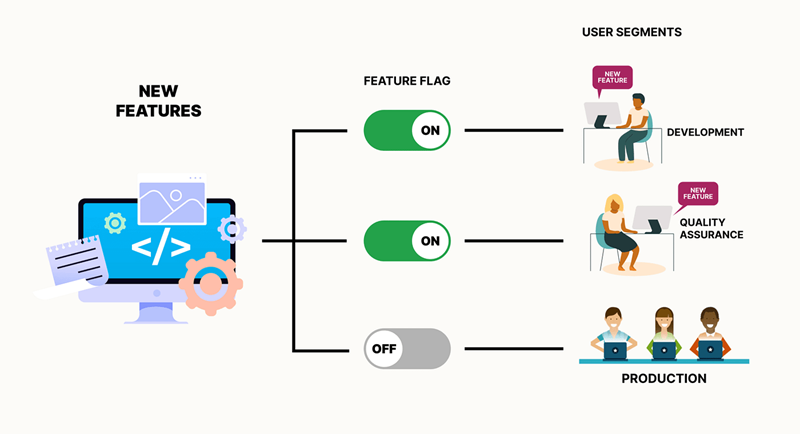Feature Flags, also known as Feature Toggles, are powerful techniques that allow developers to modify a system’s behavior without altering the code. They offer the ability to hide, enable or disable the feature during runtime, thus providing greater flexibility and control over the functionalities. Implementing Feature Flags in your projects requires adherence to a set of best practices to ensure its effective utilization.
Firstly, it is crucial to maintain a well-organized and centralized system for managing your feature flags. This includes having a unified dashboard that provides a comprehensive view of the status of all flags across multiple environments. It is also essential to keep the flags consistent across all services, to avoid any potential confusion or miscommunication.
Secondly, always ensure to name your flags clearly and descriptively. This aids in eliminating any ambiguity and assists other team members in understanding the purpose of each flag. Additionally, documenting the flag, its purpose, and its expected behavior can contribute significantly to easier management and lesser confusion.
Thirdly, remember to remove old and irrelevant flags after their purpose has been served. Keeping unused or unnecessary flags can lead to clutter and can make the system more complex and harder to manage.
Fourthly, use the strategy of gradual rollout of features. This involves exposing the new features to a small group of users initially, before making it available to everyone. This method can help in identifying any issues or bugs at an early stage, thereby reducing the risk of large-scale issues.
Fifthly, implement a robust system for error handling. The system should be capable of reverting back to a stable state in case of any failures, ensuring the smooth functioning of the application.
Lastly, it is beneficial to use a feature flag management platform or service that can provide additional functionalities such as flag segmentation, management of flag lifecycles, and provision of analytics.
By following these best practices, you can ensure that you are harnessing the full potential of feature flags, thereby improving the flexibility, control, and the overall quality of your project.

Understanding the Basics of Feature Flags
Feature flags, also known as feature toggles, are a powerful tool in software development that allow programmers to turn certain features of an application on or off at runtime, without deploying new code. They provide developers with the ability to manage and control the functionality of their software, even after it has been deployed. Understanding the basics of feature flags is essential for efficient and successful software development.
The core purpose of feature flags is to decouple the process of deploying code from the act of releasing features. This means that developers can push code into production at any time, but only expose the new features to users when they’re ready. This significantly reduces the risk associated with deploying new code and enables continuous delivery.
Feature flags can be used in several ways. For instance, they can be used for testing new features in a production environment, a practice known as ‘canary releasing’. Here, a new feature is released to a small set of users to gather feedback and identify potential issues before it’s rolled out to everyone. Feature flags can also be used to create a ‘kill switch’, which allows developers to quickly turn off a feature if it’s causing issues.
In addition, feature flags can be used to personalize user experiences. Different users can see different features based on their specific needs or preferences. This can be incredibly beneficial for meeting diverse user requirements and improving overall user satisfaction.
Despite their benefits, feature flags should be used judiciously. Improper use can lead to an overly complex codebase and difficulty in managing which features are turned on or off. Therefore, it’s crucial to have a clear strategy and process for implementing and managing feature flags.
Understanding the basics of feature flags is just the first step. To truly leverage their potential, developers must also comprehend how to use them effectively in different situations and how to manage the associated challenges. With proper knowledge and usage, feature flags can be a game-changer in software development.
Steps to Successfully Implement Feature Flags
Implementing feature flags, also known as feature toggles, in your software development process can greatly improve the flexibility and control over your product’s functionalities. The first step in successfully utilizing feature flags is to clearly define the feature scope. This involves identifying which aspects of your software’s functionality would benefit from being controlled by a flag. The next step is to design your flags. They can either be toggle-based, permitting a simple on/off control, or they can be more complex, allowing a range of controls over the feature.
Once the flags are designed, the next step is to implement them into your codebase. This requires careful planning and structured programming to ensure that the flags can easily be toggled without disrupting other code functionalities. You must also ensure that your flags are easy to understand, maintain, and manage. This can be achieved by adopting naming conventions and maintaining comprehensive documentation.
After implementation, it’s crucial to test your feature flags thoroughly. This will help identify any potential issues before deploying to production. Remember to test both states of the flag (on and off) and any dependencies between flags. Make sure that your testing environment closely mirrors your production environment to ensure accurate results.
The final step in the successful implementation of feature flags is managing them effectively. This involves constant monitoring to ensure they are working as expected and regular audits to remove obsolete flags. It also includes managing the flag lifecycle, which involves deciding when to introduce a new flag, when to activate it, and when to retire it.
With these steps, you can successfully implement feature flags in your software development process. It’s an advanced technique that, when done correctly, can allow for safe testing, gradual feature rollouts, and quick rollback of features if issues arise.

Choosing Between Configuration Files and Databases
When deciding between configuration files and databases, several factors should be taken into consideration. First, the complexity of the data structure is of utmost importance. Databases are ideal for storing complex and related data due to their ability to create relationships between different data points. They also excel in handling large volumes of data. On the other hand, configuration files are better suited for storing simple, unrelated data structures. They are ideal when there’s a need for human readability and easy manipulation of data without the use of specialized tools.
Another critical factor is the required level of security. Databases generally have built-in security measures, making them a suitable choice for sensitive data. Contrarily, configuration files might lack these security elements, making them less secure for storing sensitive data.
The speed and performance of your system can also guide your choice. Databases, especially relational ones, can slow down as the amount of stored data increases. Retrieving data from a database can also take longer than from a configuration file. However, databases offer powerful querying capabilities, which might outshine the speed advantage of configuration files when complex data retrieval is needed.
Lastly, the development and maintenance cost should be considered. Configuration files require less development effort and resources, making them a cheaper option. However, as the complexity and size of data increase, maintaining and managing configuration files can become cumbersome and error-prone, leading to higher long-term costs.
In conclusion, the choice between configuration files and databases largely depends on the specific requirements and constraints of your project. It’s essential to carefully analyze these factors to make an informed decision that balances practicality, performance, and cost-effectiveness.
Setting Up an Audit Logging System
Setting up an audit logging system is an essential process in the information technology sector, particularly for businesses that manage sensitive data. Its primary function is to record and monitor all activities within a system, which can be used for various purposes such as troubleshooting, performance evaluation, and security breach detection.
In setting up an audit logging system, the first step is to define what needs to be logged. This could include user activities, system changes, or data access. Once the requirements are defined, the next step is to choose an appropriate software application that can effectively log these activities. The chosen software should have the capability to record activities in a clear and detailed manner, as well as provide functionalities for easy retrieval and review of logs.
It is also crucial for the software to have robust security features to ensure that the logs themselves are not tampered with. After the software has been installed, the next steps involve configuring the settings to align with your specific requirements, and training the relevant personnel on how to use the software. Regular testing and reviews should also be conducted to ensure the system is functioning correctly and efficiently. In conclusion, setting up an audit logging system involves careful planning and selection of the appropriate software, as well as ongoing management and review to ensure its effectiveness and reliability.

Maintaining Feature Flag Hygiene
Maintaining feature flag hygiene is an essential practice in the software development process. It involves meticulously managing, organizing, and removing feature flags once they’ve served their purpose. Feature flags, also known as feature toggles, are powerful tools that allow developers to enable or disable features in a software application. However, when used carelessly, they can become technical debt, cluttering the codebase and increasing its complexity.
Proper feature flag hygiene involves several best practices. First, always document your feature flags. This includes writing a clear, concise description of what the flag does, why it was introduced, and when it should be removed. This will provide a roadmap for other developers who encounter the flag in the future and help prevent confusion or misinterpretation.
Regularly auditing feature flags is another crucial aspect of maintaining hygiene. This involves periodically reviewing all active flags to ensure they are still relevant and necessary. If a flag is no longer needed, it should be promptly removed to prevent code rot.
Implementing a system for flag expiration can also be highly beneficial. This could involve setting a predetermined lifespan for each flag. Once this timeframe has elapsed, the flag would automatically be reviewed and considered for removal.
In addition, teams should establish clear ownership for each flag. The owner is responsible for the flag’s lifecycle, including its creation, documentation, usage, and removal. This helps ensure that every flag is properly managed and that no flags are left to linger in the codebase indefinitely.
Furthermore, it’s important to use feature flags sparingly and judiciously. While they can be incredibly useful, they can also add unnecessary complexity when overused. Therefore, they should be used as a strategic tool, not as a crutch or a quick fix.
Finally, tools and platforms that provide feature flag management can greatly aid in maintaining hygiene. These platforms provide visibility into your flag ecosystem, automate the auditing process, and can even enforce flag expiration rules.
In conclusion, maintaining feature flag hygiene is a key aspect of responsible software development. It requires a proactive, disciplined approach, but the benefits in terms of code quality and maintainability are well worth the effort.
